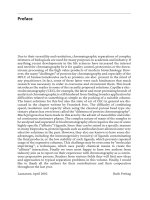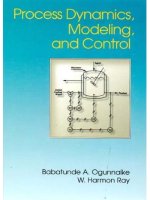biotreatment downstream processing and modelling advances in biochemical engineering
Bạn đang xem bản rút gọn của tài liệu. Xem và tải ngay bản đầy đủ của tài liệu tại đây (10.32 MB, 208 trang )
56
Advances in Biochemical Engineering
Biotechnology
Managing Editor: T. Scheper
Springer
Berlin
Heidelberg
New York
Barcelona
Budapest
Hong Kong
London
Milan
Paris
Santa Clara
Singapore
Tokyo
Biotreatment,
Downstream Processing
and Modelling
With Contributions by
P. Bajpai, P. K. Bajpai, D. Dochain, N. N. Dutta,
A. C. Ghosh, R. K. Mathur, A. Mukhopadhyay,
M. Perrier, P. L. Rogers, H. S. Shin, B. Wang
With 41 Figures and 32 Tables
Springer
ISBN 3-540-61485-0 Springer-Verlag Berlin Heidelberg NewYork
Library of Congress Catalog Card Number 72- ! 52360
This work is subject to copyright. All rights are reserved, whether the whole or part of the
material is concerned, specifically the rights of translation, reprinting, re-use of illustrations,
recitation, broadcasting, reproduction on microfilms or in other ways, and storage in data
banks. Duplication of this publication orparts thereof is only permitted underthe provisions
of the German Copyright Law of September 9,1965, in its current version, and a copyright
fee must always be paid.
Springer-Verlag Berlin Heidelberg 1997
Printed in Germany
The use of registered names, trademarks, etc. in this publication does not imply, even in the
absence of a specific statement, that such names are exempt from the relevant protective
laws and regulations and therefore free for general use.
Typesetting: MacmillanIndiaLtd., Bangalore-25
SPIN: 10474146 02/3020-5432 1 0-Printedonacid-freepaper
Managing Editor
Professor Dr. T. Scheper
Institute of Technical Chemistry, .University of Hannover
Callinstral3e 3, D - 30167 Hannover, FRG
Editorial Board
Prof. Dr.
W. Babel
Prof. Dr.
H.W. Blanch
Prof. Dr.
Ch. L. Cooney
Prof. Dr.
S O. Enfors
Prof. Dr.
K. -E. L. Eriksson
Prof. Dr.
A. Fiechter
Prof. Dr.
A. M. Klibanov
Prof. Dr.
B. Mattiasson
Prof. Dr.
S. B. Primrose
Center of Environmental Research
Leipzig-Halle GmbH
Section of Environmental Microbiology
Peermoserstrage 15
D-04318 Leipzig/FRG
University of California
Department of Chemical Engineering
Berkely, CA 94720-9989/USA
Massachusetts Institute of I'echnology
Department of Chemical Engineering
25 Ames Street
Cambridge MA 02139/USA
Department of Biochemistry and Biotechnology
Royal Institute of Technology
Teknikriugen 34, S- 100 44 Stockholm/Sweden
Department of Biochemistry
A214 Life Science Building
The University of Georgia
Athens, GA 30602-7229/USA
Institut ~r Biotechnologie
EidgenOssische Technische Hochschule
ETH-HOnggerberg, CH-8093 Z0rich/Switzerland
Massachusetts Institute of Technology
Department of Chemistry
Cambridge, MA 02139/USA
Department of Biotechnology
Chemical Center, Lund University
P.O. Box 124, S - 221 00 Lund/Sweden
21 Amersham Road
High Wicombe, Bucks HP 13 6QS/U.K.
VI Editorial Board
Prof. Dr.
14. J. Rehm
Prof. Dr.
P. L. Rogers
Prof. Dr. ~
Sahm
Prof. Dr.
K. Schiigerl
Prof. Dr.
G. T. Tsao
Dr.
K. Venkat
Prof. Dr.
John Villadsen
Prof. Dr.
U. von Stockar
Prof Dr.
C. Wandrey
Westffilische Wilhelms Universitfit
Institut Nr Mikrobiologie
Corrensstr. 3, D - 48149 Mt~nster/FRG
Department of Biotechnology, Faculty of Applied
Science, The University of New South Wales
Sydney 2052/Australia
Institut fur Biotechnologie
Forschungszentrum J01ich GmbH, D- 52428 JUlichJFRG
Institut f'tir technische Chemie, Universitat Hannover
Callinstr. 3, D-30167 Hannover/FRG
Director, Lab. of Renewable Resources Eng.
A. A. Potter Eng. Center, Purdue University
West Lafayette, IN 47907/USA
Phyton Inc., 125 Langmuir Lab
95 Brown Road, Ithaca, NY 14850-1257/USA
lnstituttet tbr Bioteknologi, Dept. of Biotechnology
Technical University of Denmark
Bygning 223, DK-2800 Lyngby/Denmark
InstitutdeGdnieChimique
Ddpartement de Chimie
Ecole Polytechnique F6ddrale de Lausanne
CH- 1015 Lausanne/Switzerland
Institut flJr Biotechnologie
Forschungszentrum Jtilich GmbH
Postfach 1913, D - 52428 Jtilich/FRG
Attention all "Enzyme Handbook" Users:
A file with the complete volume indexes Vols. l through ll in
delimited ASCII format is available for downloading at no charge
from the Springer EARN mailbox. Delimited ASCII format can be
imported into most databanks.
The file has been compressed using the popular shareware program
"PKZIP" (Trademark of PKware INc., PKZIP is available from most
BBS and shareware distributors).
This file distributed without any expressed or implied warranty.
To receive this file send an e-mail message to:
The message must be: "GET/ENZHB/ENZ_HB.ZIP".
SPSERV is an automatic data distribution system. It responds to
your message. The following commands are available:
HELP
DIR (name)
INDEX (name)
CD <name>
SEND <filename>
GET <filename>
returns a detailed instruction set for the
use of SVSERV,
returns a list of files available in the
directory "name",
same as "DIR"
changes to directory "name",
invokes a message with the file "filename"
same as "SEND".
Table of Contents
Realities and Trends
in Enzymatic
Prebleaching
of Kraft Pulp
P. Bajpai, P. K. Bajpai 1
Biotransformation
for L-Ephedrine Production
P. L. Rogers, H. S. Shin, B. Wang 33
Inclusion Bodies and
Purification of
Proteins
in
BiOlogically Active Forms
A. Mukhopadhyay 61
Extraction and Purification of Cephalosporin Antibiotics
A. C. Ghosh, R. K. Mathur, N. N. Dutta 111
Dynamical Modelling, Analysis, Monitoring and Control
Design for Nonlinear Bioprocesses
D. Dochain, M. Perrier 147
Author Index Volumes 51 - 56 199
Subject Index 203
Realities and Trends in
Enzymatic Prebleaching of Kraft Pulp
Pratima Bajpai and Pramod K. Bajpai
Chemical Engineering Division,
Thapar Corporate Research & Development Centre,
Patiala-147 001, India
List of Abbreviations 2
1 Introduction 3
2 Origin of Enzymes in Bleaching 5
3 The Action of Xylanases on Pulp 7
4 Production of Xylanases for Bleaching , 7
5 Factors Affecting the Performance of the Enzymes 8
5.1. Effects of Process Conditions on Enzyme Performance 8
5.1.1 PH 8
5.1.2 Temperature 9
5.1.3 Enzyme Dispersion 9
5.1.4 Reaction Time 10
5.2 Effects of Mill Operations on Enzyme Performance 10
5.2.1 Raw Material 10
5.2.2 Pulping Process 10
5.2.3 Brown Stock Washing 11
5.2.4 Bleaching Sequence 11
6 Enzyme Treatment in Mills 12
7 Effect of Xylanase on Conventional and Unconventional Bleaching 12
7.1 Lab Trials with Xylanases 13
7.2 Plant Scale Trials with Xylanases 22
8 Benefits from Xylanase Treatment 25
9 Future Developments 26
10 Conclusions 27
11 References 27
Use of biotechnology in pulp bleaching has attracted considerable attention and achieved interest-
ing results in recent years. Enzymes of the bemicellulolytic type, particularly xylan-attacking
enzymes, xylanases, are now used in commercial mills for pulp treatment and subsequent incorpora-
tion into bleach sequences. There are various reasons for mills to consider the use of bleaching
enzymes. Some of the primary reasons are environmental (e.g. reductions in chlorine, chlorine
dioxide, and hypochlorite) or economic (decreased chlorine dioxide and/or peroxide requirement),
or relate to improved pulp quality (higher brightness ceiling) and improved mill flexibility.
Although environmental pressures on the pulp producers were responsible for the initial interest
in new technologies or biochemical solutions for eliminating chlorine-containing chemicals, which
may still be the case in certain parts of the world, there is now a consumer-ted demand for elemental
chlorine-free (ECF) and total chlorine-free (TCF) pulps. ECF and TCF pulp production offer
opportunities for enzymes, which provide a simple and cost-effective way to reduce the use of
bleaching chemicals. Enzymes also offer an approach to addressing the need for the elimination of
bleach plant effluent discharge. The current developments in enzymatic prebleaching are reviewed
here within an engineering context.
Advances in Biochemical Engineering
Biotechnology, Vol. 56
Managing Editor: Th. Scheper
9 Springer-Verlag Berlin Heidelberg 1997
2
List of Abbreviations
Pratima Bajpai and Pramod K. Bajpai
AOX
BOD
COD
DP
DMSO
ECF
ISO
MCC
PV
TCF
TOC1
Adsorbable organic halogens
Biochemical oxygen demand
Chemical oxygen demand
Degree of polymerization
Dimethyl sulphoxide
Elemental chlorine free
International standard organization
Modified continuous cooking
Photovolt
Total chlorine free
Total organic chlorine
Bleaching stages
C
CD
(C + D)
C/D
D
Dc
D/C
E
EH
Eo
Eop
Ep
H
O
P
Q
X
Z
Chlorination
Chlorination, with addition of a small amount of chlorine dioxide
Chlorination, with a mixture of chlorine and chlorine dioxide with
chlorine in excess
Sequential bleaching, with chlorine and subsequent treatment with
chlorine dioxide without washing between the addition of chemicals
Chlorine dioxide treatment
Chlorine dioxide treatment with addition of a small amount of
chlorine
Sequential bleaching, with chlorine dioxide and subsequent chlori-
nation without washing between the addition of chemicals
Alkaline extraction
Alkaline extraction in the presence of hypochlorite
Alkaline extraction in the presence of oxygen
Alkaline extraction in the presence of oxygen and hydrogen peroxide
Alkaline extraction in the presence of hydrogen peroxide
Hypochlorite treatment
Oxygen delignification
Hydrogen peroxide treatment
Chelation of metals
Enzyme treatment
Ozone treatment
Realities and Trends in Enzymatic Prebleaching of Kraft Pulp
1 Introduction
A vast pulp and paper industry exists around the world to supply an ever
increasing demand for a wide variety of paper products. The kraft process is the
world's major pulping method and is likely to remain so in the foreseeable
future. It has evolved over a period of 100 years and has became highly refined.
Currently more than 70% of the world's annual pulp output of approximately
100 million tonnes is produced by the kraft process. Despite some shortcomings,
it is the most cost-effective, versatile and efficient wood delignification method
available. Because of this fact and the large amount of capital already invested in
kraft pulping, it is unlikely that the process will be replaced in the near future.
The kraft process results in the degradation and solubilization of lignin.
Wood chips are cooked in a solution of Na2S/NaOH at about 170 ~ for about
2 h to degrade and solubilize the lignin [1, 2]. The lignin undergoes a variety of
reactions but the most important of these results in partial depolymerization
and formation of ionizable (mainly phenolic hydroxyl) groups; these changes
lead to the dissolution of lignin in the alkaline pulping liquor. The lignin
reactions involved in kraft pulping have been studied extensively [3~6]. About
90% of the lignin is removed, the 10% or so remaining in the pulp is primarily
responsible for the brown colour characteristic of kraft pulp and papers. The
lignin remaining in the pulp has been heavily modified and its persistance
probably reflects covalent binding to the hemicelluloses [7]. The brown colour
is due to various conjugated structures including quinones, complexed cat-
echols, chalcones and stilbenes, which absorb visible light [3, 8].
Almost half of the kraft pulp produced annually is bleached before use.
Because the bleaching process is costly and results in some weight loss, bleached
kraft pulp sells for about 10-20% more than unbleached pulp. Bleaching is done
by processes employing mainly chlorine and its oxides. The residual lignin is
degraded and dissolved in various sequences of bleaching and extraction steps in
which chlorine, hypochlorite, chlorine dioxide, oxygen and hydrogen peroxide
are used. The use of chlorine as a bleaching agent is a cause for environmental
concern since the process produces dioxins and other organochlorine com-
pounds which contribute to the discharge of AOX (adsorbable organic halo-
gens) into receiving water. Gaseous chlorine and hypochlorite are blamed for
the formation of chlorinated organic compounds [9, 10].
The conventional way of bleaching kraft pulp has developed during the years
and currently the most likely sequence is a C/DEDED for softwood and
DEDED for hardwood, although a short version, DEDD, is used by modern
mills. This means that most of the hardwood bleach sequences are already
elemental chlorine free (ECF), and as the degree of substitution in softwood
bleaching is also increasing and approaching 100% (Fig. 1) [11], the kraft mills
will soon produce mainly ECF pulps. Also, the demand for total chlorine-free
(TCF) pulps is expected to increase but at the moment, there is considerable
debate and no clear agreement on a forecast for the rate of growth or the
4
Pratima Bajpai and Pramod K. Bajpai
100
ASO
._~
.~6o
"5 40
0 20
1970
Softwood
m'A Hardwood
1980
1990
u///
////~
"///A
i/i/i
,////
Y///~
Ill.L,
"///%
"////
i////
/////
i////
,///i
////,
1995
Fig. 1. Replacement of C with
D in the first chlorination stage
[11]
10
A6
LL
~4
I I I
1980
I , I
1990 1;95
Fig. 2. Proportion of TCF in to-
tal pulp production [11, 12]
ultimate size of the TCF market. It was estimated [12] that 3-3.5 million tons of
TCF pulps would be produced in 1993 (10% of kraft pulp) with an annual
growth rate of 1-1.5 million tons (Fig. 2) [11]. The chlor-alkali producers also
have different views on whether or when a phase-out of chlorine will occur in the
pulp and paper industry [13]. In the end, the deciding factors will be the success
of environmental groups in their moves against the use of chlorine and con-
sumer demands for chlorine-free paper. The success of pulp and paper industry
in informing the general population and overcoming the more emotive issues
with clear scientific data will also have an influence. Regardless of the pace of
change, a market has been created for ECF and TCF pulps where either
alternatives have to be found to chlorine-containing bleaching chemicals or new
technologies have to be considered. The options open to pulp mills considering
a change to chlorine-free bleaching are shown in Table 1 and most of these
involve process modifications and/or capital investment. This climate of change
has provided an opportunity for enzymes [14-30]. The use of enzymes is an
Realities and Trends
in
Enzymatic Prebleaching of Kraft Pulp
Table 1. Alternatives available to produce TCF or ECF pulps
Alternatives Advantages Disadvantages
Susbstitution of chlorine Lower AOX
dioxide for chlorine
Oxygen deligniflcation
to reduce kappa
prior
to bleaching
Hydrogen peroxide to replace
chlorine-based chemicals
Ozone to replace chlorine-based
chemicals
Extended cooking to reduce
the kappa number before
bleaching
Enzymes
Lower AOX
Lower bleaching
costs
Lower AOX
Lower AOX
Lower AOX
Lower bleaching
costs
Lower AOX
Reduced use of bleaching
chemicals
Minimal capital
investment
Improved strength and
brightness
High bleaching costs
High investment may be required
to satisfy increased demand for
chlorine dioxide
High investment
High bleaching costs
Risk of pulp viscosity
and strength
Very high investment
Risk of pulp viscosity and strength
High investment
Chances of reduction
in yield due to some loss of
hemicellulose
innovative answer to chlorine-reduced and chlorine-free bleaching of kraft pulp.
In this article, an overview of the recent developments in the application of
enzymes in kraft pulp bleaching is presented. The results of international
research on the use of enzymes in bleaching, the opportunities for using en-
zymes, the impact of enzymes on bleaching performance and the contribution of
enzymes to the economics of pulp bleaching are discussed. Future pros-
pects/developments in this area are also discussed. Because this is a rapidly
emerging field, much of the literature is found in symposium proceedings rather
than in the peer-reviewed journals.
2 The Origin of Enzymes in Bleaching
The enzymes used commercially in pulp bleaching are hemicellulases, which
selectively affect the accessible hemicellulose fraction of wood pulps. A number
of enzymes have been studied but xylanases have been shown to be most
effective. The concept of biological bleaching with xylanase emerged from efforts
to selectively remove hemicellulose from chemical pulps to produce cellulose
acetate [31]. At approximately the same time, a research program jointly carried
6
/ o CH3O o ]
L gnn
0 0 OCH3
•
Pratima Bajpai and Pramod K. Bajpai
Fig. 3. Possible structure of lignin-
carbohydrate complexes in unbleached
kraft pulp
out by the Finnish Pulp and Paper Research Institute and Technical Research
Centre of Finland was focusing on lignin degrading biochemical processes. It
was found that treatment of chemical pulps with xylanases leads to savings in
the consumption of bleaching chemicals, decreased environmental loadings or
increased final brightness of pulp [32-34]. Since then various papers have been
published describing the benefits of xylanase treatments in pulp bleaching.
These benefits are environmental (e.g. reductions in chlorine, chlorine dioxide,
hypochlorite), economic (decreased chlorine dioxide and/or peroxide require-
ments), improved pulp quality (higher brightness ceiling) and improved mill
flexibility. Mill trials began as early as 1989 in Finland and since 1991, commer-
cial use of xylanase has become a reality. As reported by Jurasek and Paice [35]
at the International Symposium on Pollution Prevention in the Manufacture of
Pulp and Paper, 10 mills were said to use xylanase prebleaching on a commer-
cial basis and more than 80 mill trials were carried out. In 1993, the process
gained even wider acceptance, especially in Canada and Europe. The factors
explaining this rapid development are many but can be summarized as follows:
9 Xylanase prebleaching belongs to the soft technologies that require very little
or no capital investment to operate.
9 Process changes are minimal in most cases (neutralization of brown stock).
Mill trials are very simple, inexpensive and involve minimal risk.
9 Xylanase helps to reduce pollution from bleaching.
9 Savings on chemicals can pay for the process.
9 Xylanase may help to increase mill capacity where there are chlorine dioxide
limitation.
9 The process is easily combined with many bleaching sequences for ECF and
TCF pulps.
The main enzyme needed to enhance the delignification of kraft pulp is
reported to be
endo-f~-xylanase
(EC 3.2.1.8) but enrichment of xylanase with
Realities and Trends in Enzymatic Prebleaching of Kraft Pulp 7
other hemicellulolytic enzymes has been shown to improve the effect of enzy-
matic treatment 1-34, 36-40]. In the enzymatic pretreatment for bleaching, the
hydrolysis of hemicellulose is restricted to a minimum by using only a small
amount of enzymes in order to maintain a high pulp yield and the advantageous
properties of hemicellulose in pulp [32-33]. Hemicellulose in pulp plays an
important role both in fibre morphology and fibre physics. Retention of
hemicellulose increases the pulp yield, improves pulp strength and affects fibre
quality.
3 The Action of Xylanases on Pulp
The way in which xylanase prebleaching affects subsequent bleaching is not well
understood. One possible explanation is that the disruption of the xylan chain
by xylanases appears to cleave lignin-carbohydrate bonds (Fig. 3), improves the
accessibility of the bleaching chemicals to the pulps and facilitates easier re-
moval of solubilized lignin in bleaching. Paice et al. [40] have shown that there
is a significant decrease in xylan DP, and only a small amount of xylan is
removed during xylanase prebleaching. The decreased chain length of xylan or
its removal results in increased freedom for lignin to diffuse from the hemicel-
lulose-lignin matrix. Another possible explanation involves the role of re-
deposited xylan [29, 34, 39, 41]. It was known that parts of xylan initially
dissolved in kraft cooking liquor could be readsorbed or reprecipitated on and
within the pulp fibres. The redeposited xylan may physically shield the residual
lignin from bleaching chemicals. Xylanases hydrolyze part of the redeposited
xylan, allowing better access of bleaching chemicals to the residual lignin and
easier extraction of lignin from pulp fibres. However, this theory is still not
conclusive. Pederson et al. [42] found that the xylanase specifically attacks
a small fraction of the xylan in pulp fibres and demonstrated that the removal of
reprecipitated xylan with dimethylsulphoxide (DMSO) does not improve the
bleachability of the pulp. Therefore, he concluded that the DMSO-extractable
xylan was not involved in bleach boosting.
4 Production of Xylanases for Bleaching
Several criteria are essential for choosing a microorganism to produce
xylanases. In addition to giving the desired biobleaching effect, the resulting
enzyme preparation must be produced in sufficiently high quantity and the
xylanase technology must be compatible with the technology of a pulp mill.
Also, it is very essential that the enzyme preparation should be completely free of
8 Pratima Bajpai and Pramod K. Bajpai
cellulase side activity. Any cellulase activity will have serious economic implica-
tions in terms of cellulose loss, degraded pulp quality and increased effluent
treatment cost. Noncellulolytic preparations have been produced by recom-
binant DNA technology selective inactivation or bulk scale purification
[36, 43, 44].
High productivity has been achieved by exhaustive screening, genetic engin-
eering and growth optimization programs. To produce xylanases, the selected
organism is grown for several days in sealed process vessels containing nutrients
and oxygen under specific conditions of pH, temperature and agitation. During
this time, it secretes enzymes into the growth medium. The living cell mass is
then removed, leaving a xylanase rich liquid. This is then concentrated, assayed
to determine its activity and packaged for shipment to pulp mills. With the
addition of bacteriostatic preservatives, the xylanase preparation remains stable
for months. Excessive temperature or freezing can cause loss of activity and
should be avoided. The xylanase preparation is not corrosive or reactive and
does not need resistant materials for handling.
Table 2 shows the list of some of the commercial xylanases used for pre-
bleaching. The cost of enzyme preparation is in the range of $2-7 t- ~ pulp
processed depending on specific bleaching conditions. Ecopulp XM contains
both xylanase and mannanase. The later is targeted at the glucomannan in
softwoods.
5 Factors Affecting the Performance of Enzymes
5.1 Effects of Enzyme Process Conditions on Enzyme Performance
Because of the nature of the enzyme/pulp interaction, several factors must be
taken into account in order to use enzymes effectively in a mill. Although all of
the commercial enzymes act primarily on xylan, the conditions for mill usage are
quite different. In addition, to get best value from enzyme usage, the conditions
chosen for any one enzyme should be tailored to each mill, based upon careful
laboratory testing. The key factors include the pH, temperature, enzyme disper-
sion and reaction time.
5.1.1pH
The pH optimum and operating range for enzyme treatment varies among
enzymes but generally falls between pH 4 and 8. It is important to note,
however, that the optimum pH for a given enzyme may vary among mills, due to
different operating conditions described above [45, 46]. Because of this, the
optimum pH must be determined for each mill. For some enzymes, the pH
Realities and Trends in Enzymatic Prebleaching of Kraft Pulp
Table 2. Commercial xylanases
Product Supplier Approximate price
($/kg)
Pulpzyme HA Novo Nordisk, Denmark 10
Pulpzyme HB Novo Nordisk, Denmark 6
Pulpzyme HC Novo Nordisk, Denmark n.a. a
Irgazyme 10 Genencor, Finland n.a.
Albazyme 10 Ciba Geigy, Switzerland
Irgazyme 40-4X Genencor, Finland 16
Albazyme 40-4X Ciba Geigy, Switzerland
Cartazyme HS Sandoz Chemicals, U.K. 30
Cartazyme HT Sandoz Chemicals, U.K. n.a.
Bleachzyme F Biocon India, Bangalore 10
VAI Xylanase Voest Alpine, Austria n.a.
Ecopulp X-200 Alko Ltd. Biotechnology, Finland 7.5
Ecopulp XM Alko Ltd. Biotechnology, Finland n.a.
Xylanase Iogen Corporation, Canada n.a.
Xylanase L-8000 Solvay Interox, USA n.a.
Ecozyme Zeneca Bioproducts n.a.
ICI, Canada
"n.a. Not available
optimum spans at least one pH unit, which has proven to be well within the
capabilities of pH control of the brown stock. The breadth of pH range is
another property that varies among enzymes.
5.1.2 Temperature
The temperature optimum and operating range for enzyme treatment varies
among enzymes but is between 35 ~ and 60 ~ Cooler temperatures result in
similar effects, but over longer treatment times. The maximum operating tem-
perature differs among enzymes. For a given enzyme, the maximum operating
temperature varies among mills, mostly due to differences in the extent of brown
stock washing [45].
5.1.3 Enzyme Dispersion
The adequate dispersion of enzyme and acid into the pulp is extremely impor-
tant for enzyme performance. Tracer studies should be conducted at each new
installation to assess the adequacy of the dispersion. In general, the degree of
mixing depends on the equipment that is used to add enzyme to the pulp and on
the absorbency of the brown stock. While medium consistency pumps usually
provide adequate mixing of the enzyme into the pulp, the results with thick
stock pumps are highly variable. Thick stock pump systems can, however, be
10 Pratima Bajpai and Pramod K. Bajpai
configured to approach the mixing performance of a medium consistency pump.
The configuration of the optimal system will depend on the specific layout,
equipment and metallurgy of the mill.
5.1.4 Reaction Time
A minimum of 1 to 2 h of residence time is required for the enzyme treatment.
There is little enzyme action on the pulp beyond 4 to 6 h.
5.2 Effects of Mill Operations on Enzyme Performance
Mill operations also affect the performance of enzymes. The effects of (1) raw
material, (2) pulping process, (3) brown stock washing and (4) bleaching se-
quence should be assessed by laboratory testing prior to mill usage of enzymes.
5.2.1 Raw Material
Among raw materials, the most important distinction is between hardwood and
softwood because the respective hemicellulose structures are different. Most of
the mill experience has been with softwood. In general, hardwood hemicellulose
is more accessible to xylanase enzyme action than is softwood. The magnitude of
enzyme benefit is thus greater on hardwood than on softwood. Among hard-
wood and softwood species, there is some variation in the response to enzyme
treatment. However, these differences are not nearly as significant as the effects
of the pulping operations.
5.2.2 Pulping Process
The pulping process can affect the content and structure of the hemicellulose in
the pulp. This, in turn, changes the extent of enzyme action that is achievable
with the pulp. For example, sulfite pulping destroys most of the hemicellulose
and thus sulfite pulp is not suitable for enhanced bleaching by enzymatic
treatment. Kraft pulping at severe conditions, such as conventional cooking of
softwood to kappa number less than 23, also destroys much of the hemicellulose
that is accessible to the enzyme. On the other hand, MCC or oxygen-delignifed
pulps with low unbleached kappa number respond well to enzyme treatment
[45]. Tolan [45] reported a much smaller enzyme benefit for batchcooked pulp
at kappa number 21 than for MCC and oxygen-delignified pulp at the same
kappa number. The MCC and oxygen-delignified pulps have hemicellulose
structures that are similar to that for conventional, high kappa number pulps.
Enzyme benefits have been achieved in mills with conventional, MCC and
oxygen delignification systems [45, 46].
Realities and Trends in Enzymatic Prebleaching of Kraft Pulp
| 1
Table 3. The effect of hemicellulases on the peroxide delignification of unbleached birch and pine
kraft pulp
Treatment Birch kraft pulp Pine kraft pulp
Kappa Brightness Viscosity
No. (% ISO) (mPa s)
Kappa Brightness Viscosity
No. (% ISO) (mPa s)
Enzyme from
A. awamori
(500 nkat g -~ ) 8.3 65 8.2 13.1
Enzyme from
A. awamori
(4000 nkat g- ~) 6.5 72 8.3
Enzyme from
S. olivochromogenes
(28 nkatg l) - - - 14.4
Buffer a washing 9.9 67 8.6 16.2
Reference (peroxide) 12.3 48 8.8 19.7
53 8.3
56 9.2
54 10.0
35 9.4
Birch kraft pulp: Original kappa No. 17.7; viscosity 13.5 mPa s
Pine kraft pulp: Original kappa No. 30.3; viscosity 11.4 mPa s
Based on data from Ref. 32
Citrate buffer
5.2.3 Brown Stock Washing
The brown stock black liquor (brown white water) properties vary greatly from
mill to mill. Some mills black liquor can inhibit enzyme performance due to the
presence of highly oxidizing compounds. This effect differs significantly among
enzymes and should always be checked before proceeding with full scale enzyme
use. In those mills where the black liquor is not inhibitory, mill experience, has
shown that the day-to-day variation in brown stock washing has little impact on
enzyme performance. However, the extent of washing can affect the maximum
enzyme treatment temperature, which is important in mills that are run as hot at
possible. For example, at 25 kg t- 1 of soda, the maximum temperature tolerated
by Iogen's enzyme is about 5 ~ less than for a typical mill-washed pulp. This
property varies among enzymes [45].
It is important to note that it is not necessary to wash the pulp after enzyme
treatment (before chlorination) to achieve the enhanced bleaching. Identical
enzyme benefits have been obtained [47-I with and without a post-enzyme
washing. This indicates, not surprisingly, that enzyme treatment does not
solubilize lignin. However, a post-enzyme washing might be beneficial to some
pulps [45, 48].
5.2.4 Bleaching Sequence
The bleaching sequence influences the enzyme's benefit to the mill in several
ways. In general, the chemical savings on softwood by enzyme treatment can be
12 Pratima Bajpai and Pramod K. Bajpai
taken as any combination of chlorine and chlorine dioxide that comprises about
15% of the total active chlorine used [46]. However, mill experience has
confirmed that lab data which showed that the chemical savings depend on the
identity and relative amounts of bleaching chemicals used (i.e. chlorine dioxide
substitution, peroxide, oxidative extraction) as well as on the relative balance
between chemical usage in the delignification. When a mill varies its bleaching
sequence, it can expect a change in the enzyme's benefit as well. The specific
bleaching sequence should be tested on enzyme treated pulp on a laboratory
scale before mill implementation [45].
6 Enzyme Treatment in Mills
Typically the enzyme is added as an aqueous solution to the pulp at the final
brown stock washer. Because enzymes are extremely potent catalysts, the
desired effects are produced with small amounts of enzymes. The brown stock,
which (though washed) is highly alkaline (pH 9 12), must be neutralized with
acid, usually sulfuric, to be compatible with enzyme treatment.
The pulp is then pumped to the high density storage tower where the enzyme
acts. From there the enzyme treated pulp is then pumped into the first bleaching
tower where the first contact with the oxidizing chemicals destroy the enzyme.
Unlike other bleaching chemicals, xylanases do not brighten or delignify the
pulp. They modify the pulp to make the lignin more accessible to removal by
other bleaching chemicals. The enzymatically treated pulp then passes through
the bleach plant with a decreased chemical requirement for bleaching.
7 Effect of Xylanase Enzyme on Conventional and
Unconventional Bleaching
When a mill wants to either reduce its conventional bleaching costs or improve
the economy of TCF bleaching, it is faced with the fact that the existing
processing equipment has to be used. The standard process layout for conven-
tional and TCF bleaching is presented in Figs. 4 and 5. The enzyme is added
before the brown stock tower. To achieve a good effect, it has to be ensured that
mixing is sufficient both after pH adjustment and enzyme addition. In general, it
is very easy to arrange for correct addition points for both acids and enzyme. As
the amount of chemicals are small, the equipment needed for these chemicals is
also minimal. Generally, a permanent acid addition facility is installed but the
enzyme can easily be added from the container.
Realities and Trends in Enzymatic Prebleaching of Kraft Pulp
13
Pulp
input
~ pH adjustment
::[:, Enzyme
addition option
Fig. 4. Xylanase application in conventional bleaching
io
Pulp
outlet
Pulp
inlet
~ pH adjustment
I
P
-r-
Addition option for enzyme and / or chelating agent
Fig. 5. Xylanase application in TCE bleaching
Results from laboratory studies and mill trials show about 3541% reduction
in active chlorine at the chlorination stage for hardwoods and 10-26% for
softwoods, whereas savings in total active chlorine are found to be 20-25% for
hardwoods and 10-15% for softwoods, if the pulps are pretreated with xylanase
enzyme.
7.1 Lab Trials with Xylanases
Viikari and eoworkers [32] reported a 25% reduction in the consumption of
active chlorine by the enzymatically pretreated pine kraft pulp or for the same
charge of active chlorine, delignification to lower kappa numbers (a measure of
14 Pratima Bajpai and Pramod K. Bajpai
residual lignin) than the reference pulps. They also reported a significant reduc-
tion in chlorine dioxide consumption by a hemicellulase-treated pine kraft pulp,
when it was subsequently bleached to 89 90% ISO brightness by a DEEDED
sequence. Kappa numbers of unbleached pine and birch kraft pulps were both
reduced by 50% from original values by treating the pulps with enzyme followed
by peroxide, with an increase in brightness concomitant with the reduction in
kappa number. These pulps were comparable to chlorine-bleached pulps
(Table 3).
Paice et al. [36] and Jurasek and Paice [49] used the pure enzymes produced
by Bernier et al. [50] from clones of Escherichia coli to remove lignin from kraft
pulp. The pulp obtained by combined enzyme and CED bleaching showed
improved brightness compared with the conventionally bleached pulp. The final
brightness ofenzymatically treated pulp was 83.2% which was 3.2 points higher
than the control.
Senior et al. [48, 51-54] conducted a systematic study on the effect of xylanase
upon C/DEDED sequence using different levels of chlorine dioxide substitution
and kappa factor, where kappa factor is the amount of chlorine, in weight
percent of pulp, divided by kappa number. They found reduced chemical use
and higher brightness for both hardwood pulps and softwood pulps (Tables
4 and 5). The maximum xylanase effectiveness was achieved at low chlorine
dioxide substitution for hardwood pulps and at low or high substitution for
softwood pulps.
Repligen Sandoz Research Corporation and the Department of Wood and
Paper Science at the North Carolina State University developed the xylanase
enzyme Cartazyme HS with no contaminating cellulase side activity. The use of
Cartazyme helped to achieve chlorine-free bleaching, resulting in a pulp with
89.6% brightness compared to a control sample which achieved a brightness of
83.8% [55].
Clark et al. [56] evaluated the use of hemiceUulolytic enzymes for improving
the bleachability of radiata pine kraft pulp. Treatment with these enzymes was
found to produce savings of 20-25% of chlorine chemicals used during sub-
sequent bleaching. Pederson et al. [57] studied the bleach boosting of kraft pulp
with alkaline xylanase preparations completely free of cellulase. These prepara-
tions gave good bleach boosting effects at pH 8-9 on kraft pulp. Holm [27]
reported enzymatic bleach boosting of Swedish birch kraft pulp delignified with
oxygen and of a conventionally cooked Eucalyptus globulus with commercial
xylanase - Pulpzyme HB. The amount of active chlorine (in the form of chlorine
dioxide) required in subsequent bleaching was found to be reduced by 32% and
28%, respectively. Experiments with North American pine kraft also showed the
benefits of the enzyme boost process prior to an ozone bleaching sequence.
Details of this product and guidelines for its plant scale application were
reported by Gibson [58].
Tolan and Canovas [47] found that pulp treated with enzyme in
a D/CEoDED sequence using 50% chlorine dioxide substitution required 16%
less total active chlorine to obtain 90% ISO brightness. Dunlop and Gronberg
Realities and Trends in Enzymatic Prebleaching of Kraft Pulp
Table 4. Effect of xylanase treatment on C/DEDED bleaching
various kappa factors and chlorine dioxide substitutions
sequences for
15
Pulp
Chlorine dioxide Kappa Final
substitution factor brighteness
(%) (% ISO)
Control
Xylanase
pretreated
10 0.200 90.0
0.233 90.2
0.266 90.3
40 0.150 89.2
0.173 90.0
0.200 91.0
70 0.200 90.0
0.233 90.6
0.250 90.9
100 0.150 83.5
0.175 85.3
0.200 87.0
10 0.05 90.0
0.10 90.8
0.15 91.8
40 0.05 90.0
0.10 90.8
0.15 91.8
70 0.05 88.7
0.10 90.0
0.15 90.3
100 0.10 87.4
0.15 87.4
Based on data from Ref. 51
Table 5. Total chlorine and chlorine dioxide charges needed to achieve
90% ISO brightness for xylanase pretreated and untreated hardwood
pulps
Pulp
Chlorine dioxide Total chlorine
substitution charge on pulp
(%) I%)
Control 10 6.75
40 6.25
70 7.00
Xylanase 10 4.55
pretreated 40 4.70
70 5.05
Based on data from Ref. 52
[11] reported about 20-25% savings in active chlorine with hardwoods and
10-15% with softwoods using commercial enzyme Cartazyme HS-10.
Bajpai et al. [59, 60] reported that pretreatment of eucalyptus kraft pulp with
commercial xylanases - Pulpzyme HA, Novozyme 473 and VAI xylanase - in
16 Pratima Bajpai and Pramod K. Bajpai
a CEH bleaching sequence, resulted in a 31% reduction in chlorine consump-
tion at the chlorination stage. Final brightness of the pulp remained unchanged.
Pretreatment with Cartazyme HS-10 also reduced the chlorine consumption by
31% in C stage, and the brightness ceiling was increased by 2.5 points (Table 6).
At constant chemical dose, the final brightness of pulp was increased by 4.9,
3 and 2.1 points with Cartazyme HS-10, Novozyme 473 and VAI xylanase,
respectively, in a CEH sequence. Bajpai et al. [61] also reported improved
brightness of bamboo kraft pulp using xylanase in a conventional bleaching
sequence, CDEHD. It was possible to increase the final brightness of pulp by
about 1.6 points with a final brightness of 88.8% PV versus 87.2% PV in the
control. Alternatively, the enzyme could be used to decrease the active chlorine
use in the first stage of the bleaching by 20% or decrease chlorine dioxide in the
last stage of brightening by 4 kg t- t in the CDEHD sequence.
Table 6. Effect of different xylanase treatments on conventional bleaching of eucalyptus pulp
Treatment CEHH Novozyme-473 VAI Xylanase Cartazyme HS-10
XCEHH XCEHH XCEHH
Kappa No. 25.8 24.0 23.1 21.6
(control) (after enzymatic (after enzymatic (after enzymatic
pretreatment) pretreatment) pretreatment)
Chlorination
Clz added (%) 4.50 3.20 3.10 3.10
C12 consumed (%) 4.48 3.08 3.08 3.08
Final pH 1.85 2.04 1.98 1.97
Extraction
NaOH added (%) 0.8 0.8 0.8 0.8
Final pH 9.0 10.1 9.8 10.3
K. No. of pulp 5.3 5.7 5.4 4.7
Hypo-I
Clz added (%) 2.50 2.50 2.50 2.50
NaOH added (%) 0.50 0.50 0.50 0.50
CIz consumed (%) 2.49 2.49 2.49 2.38
Final pH 7.7 7.4 6.9 7.4
Hypo-II
C12 added (%) 0.75 0.75 0.75 0.75
NaOH added (%) 0.40 0.40 0.40 0.40
C12 consumed (%) 0.44 0.40 0.41 0.40
Final pH 10.5 10.6 10.5 10.6
CIz added (%) 7.75 6.35 6.35 6.35
02 consumed (%) 7.41 5.97 5.98 5.86
Brightness (% ISO) 80.2 79.7 80.5 82.7
Viscosity (mPa s) 4.90 5.24 5.24 4.67
Yield (%) 92.00 91.71 91.71 90.00
% chemicals are based on oven-dried pulp; C12 refers to active chlorine.
Conditions: X(Novozyme-473), 500 EXU kg- 1, pH 8.0, 40 ~ 60 min, 10% pulp; X(VAI Xylanase),
5000 XU kg-1, pH 6q5.2, 60 ~ 120 min, 10% pulp; X(Cartazyme HS-10), 2000 XYU kg-1, pH
4-4.5, 50~ 180 min, 10% pulp; C. pulp 3%, 30~ 45 min; E, pulp 10%, 55 ~ 90 min; H-I, pulp
10%, 40 ~ 150 min; H-II, pulp 10%, 40 ~ 60 rain.
Based on data from Ref. 60









